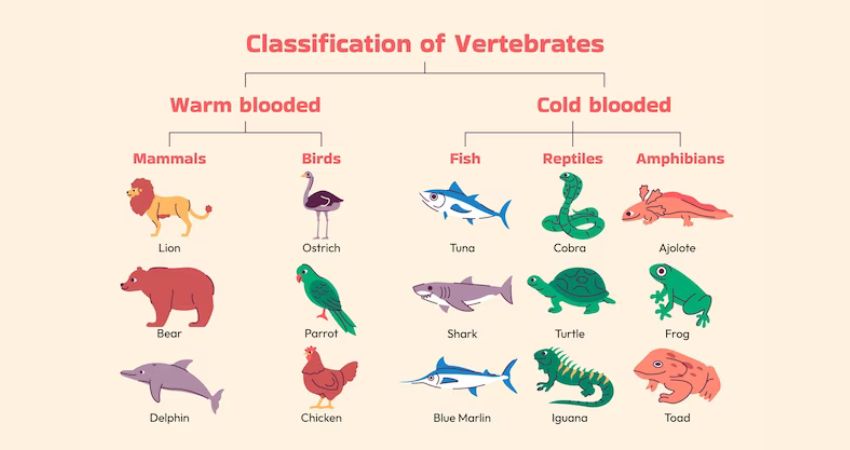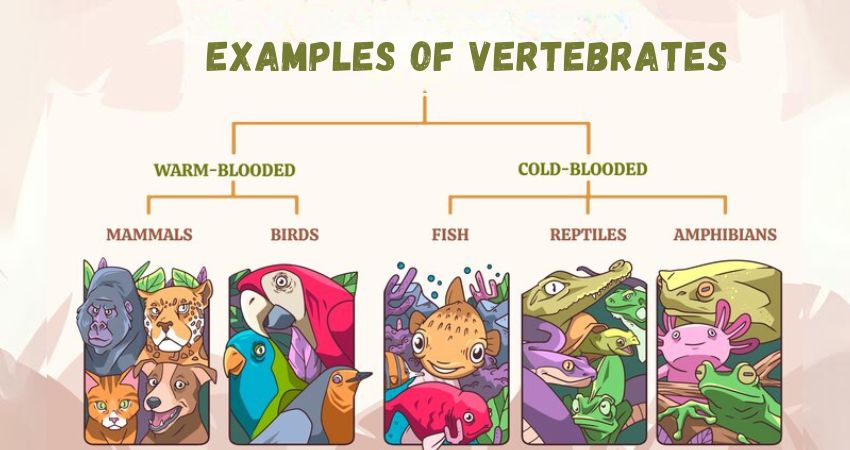Welcome to my blog about the amazing world of examples of vertebrates! These creatures are truly remarkable, with their defining feature being their backbone or spinal column. This incredible structure gives them a well-defined structure and allows them to perform a range of complex movements. From the swift agility of a cheetah to the soaring grace of an eagle, vertebrates are known for their incredible abilities.
In this blog, we will explore the warm-blooded and cold-blooded distinctions that make vertebrates unique, and delve into the fascinating tapestry of diversity that characterizes the animal kingdom. Whether you are a nature lover, a science enthusiast, or simply curious about the world around you, there is no denying the awe-inspiring beauty and complexity of vertebrates. So join me on this journey of discovery, and let’s explore the wonders of the vertebrate world together!
Definition of Vertebrates
Vertebrates, classified under the phylum Chordata, are animals characterized by the presence of a backbone or spinal column. This bony structure encases and protects the spinal cord, a crucial part of the central nervous system. Vertebrates can be found in various ecosystems worldwide, showcasing incredible adaptability.
Importance of the Backbone in Vertebrates
The backbone, or vertebral column, is a defining feature that provides structural support and protection to the spinal cord. This central structure not only facilitates movement but also serves as an anchor for muscles and organs. The vertebral column is a testament to the evolution of animals, allowing for increased complexity and mobility.
You may also like:- 25 Examples of Detritivores
Sigma Style
Examples of Vertebrates
Examples of vertebrates are described by dividing into two classification:
Warm-Blooded and Cold-Blooded Vertebrates
The examples of Warm-Blooded and Cold-Blooded Vertebrates are given below;
Warm-Blooded Vertebrates (Endotherms)
Warm-blooded, or endothermic, vertebrates possess the remarkable ability to regulate their internal body temperature independently of their environment. This adaptability enables them to thrive in diverse habitats. Let’s explore some examples:
Mammals
1. Humans (Homo sapiens)
As the pinnacle of warm-blooded adaptability, humans showcase the capacity for complex thought and cultural development. Our ability to regulate body temperature internally allows us to inhabit a vast range of environments, from icy tundras to scorching deserts.
2. Blue Whales (Balaenoptera musculus)
The largest animals on Earth, blue whales, are magnificent marine mammals. Despite their enormous size, they maintain a consistent internal temperature, allowing them to navigate the world’s oceans with ease.
3. African Elephants (Loxodonta africana)
Known as the gentle giants of the savannah, African elephants display both intelligence and adaptability. Their endothermic nature aids in navigating the diverse climates of the African continent.
Birds
4. Peregrine Falcons (Falco peregrinus)
Famed for their high-speed dives, peregrine falcons are exemplary warm-blooded vertebrates. Their ability to regulate body temperature plays a crucial role in their precision hunting and soaring through the skies.
5. Bald Eagles (Haliaeetus leucocephalus)
As the national symbol of the United States, bald eagles are not only revered for their symbolism but also for their efficient regulation of body temperature, allowing them to thrive in various habitats.
6. Emperor Penguins (Aptenodytes forsteri)
Surviving in the harsh Antarctic environment, emperor penguins demonstrate the resilience of warm-blooded vertebrates. Their ability to withstand extreme cold showcases the adaptability of endothermic animals.

Cold-Blooded Vertebrates (Ectotherms)
Cold-blooded, or ectothermic, vertebrates rely on external sources to regulate their body temperature. This dependence on environmental conditions influences their behavior and habitat selection. Let’s explore examples from various classes:
Reptiles
7. Komodo Dragons (Varanus komodoensis)
As the largest living species of lizard, Komodo dragons rely on external warmth to maintain their body temperature. Found in the Indonesian islands, they showcase the adaptability of cold-blooded vertebrates.
8. King Cobras (Ophiophagus Hannah)
Known for their impressive hood and venomous bite, king cobras are ectothermic reptiles. They bask in the sun to regulate their temperature, making them formidable hunters in their habitats.
9. Green Sea Turtles (Chelonia mydas)
These marine reptiles navigate the world’s oceans, relying on external sources of warmth. The temperature of their nesting sites even determines the sex of their offspring, highlighting the impact of environmental conditions.
Amphibians
10. Red-eyed Tree Frogs (Agalychnis callidryas)
Known for their vibrant colors, red-eyed tree frogs are ectothermic amphibians. They rely on environmental temperatures to regulate their metabolic processes, showcasing the diversity within the vertebrate class.
11. Axolotls (Ambystoma mexicanum)
Unique among amphibians, axolotls are capable of regenerating lost body parts. Their ectothermic nature allows them to thrive in aquatic environments with varying temperatures.
12. American Bullfrogs (Lithobates catesbeianus)
With their characteristic calls echoing through wetlands, American bullfrogs are cold-blooded amphibians. They rely on external warmth for activities such as feeding and reproduction.
Fish
13. Great White Sharks (Carcharodon carcharias)
As apex predators of the seas, great white sharks are ectothermic fish. Their body temperature is influenced by the surrounding water, showcasing the adaptability of cold-blooded vertebrates in aquatic environments.
14. Clownfish (Amphiprioninae)
Made famous by animated films, clownfish are ectothermic fish that rely on sea anemones for protection. Their body temperature adjusts to the temperature of the surrounding water.
15. Siamese Fighting Fish (Betta splendens)
Known for their vibrant colors and flowing fins, Siamese fighting fish are ectothermic. They inhabit shallow waters in their native Southeast Asian habitats, adapting to fluctuating temperatures.
In this journey through the diverse world of vertebrates, we’ve explored warm-blooded and cold-blooded examples, each with unique adaptations for survival. The backbone, a defining feature of vertebrates, unites these creatures across varied environments, making them essential contributors to the rich tapestry of life on Earth.

